Introduction
Most people in the wind industry know Peter Lissaman, and have seen references to his work. His 1979 article “Energy Effectiveness of Arbitrary Arrays of Wind Turbines” (Lissaman, 1979), is cited by hundreds of papers. Many of those citations are from newly published research papers, and books on advanced wind turbine wake modelling. Furthermore, he co-authored the very famous book “Applied aerodynamics of Wind Power Machines” (Wilson and Lissaman, 1974) in 1974 with Robert E. Wilson.
Mr. Lissaman passed away in 2012, he left behind him an incredible amount of remarkable contributions to the field of aerodynamics, among those: the first human powered aircraft with Paul B. MacGready, and the formation flight of birds with Carl Shollenberger.
Despite the great amount of material available on the Internet about early wind energy works (this will be further developed on this blog, keep yourself posted), three key references of the 1979 paper from Lisssaman are very difficult to locate, see below:
- (Lissaman, 1976) “Energy effectiveness of arrays of wind energy collection systems”.
- (Lissaman and Bate, 1977) “Energy effectiveness of arrays of wind energy conversion systems”.
- (Faxén, 1978) “Wake interaction in an array of windmills – theory and preliminary results”.
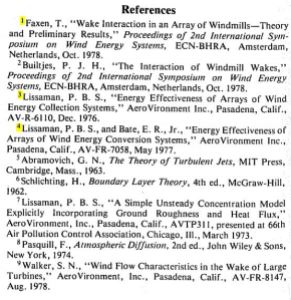
Searching for gems
After looking hours on the Internet, I eventually found and purchased a hard copy of the Wind Energy System conference (Amsterdam, October 1978), and thereby could retrieve (Faxén, 1978). However the two reports (Lissaman and Bate, 1977) and (Lissaman, 1976) were nowhere to be found.
Luckily, Nicolai G. Nygaard, who also took part in the search, found a copy of (Lissaman and Bate, 1977) from DTU Wind Energy thanks to Mr. Gunner Larsen. It was at this stage that Nicolai and I decided to reach out to Mr. Faxén.
After some failed attempts, we succeeded in contacting him, and wonderful surprise: Mr. Faxén had kept a hard copy (one of the few) of (Lissaman, 1976) dated from the 3rd of January 1977. He kindly accepted to make an electronic version, and shared it with us. Before proceeding with some technical considerations about his and Mr. Lissaman work, let me include below a description of the research work of Mr. Faxén, in his own words:
“I was involved with wind energy research and siting as part of my studies at the Meteorological Department at Uppsala University (MIUU) and Boundary Layer Meteorology, under Professor Ulf Högström in the late 1970ies. Dr Peter Lissaman and Aerovironment Inc. did a study on energy effectiveness of arrays of wind energy collection systems on behalf of a Swedish government board NE (Nämnden för energiproduktionsforskning). MIUU participated in the NE work so I was at Aerovironment working with Lissaman during the second phase of that study. I continued working with wake studies and wind energy siting for some years, primarily at the Kalkugnen windmill site in Sweden where MIUU did measurements of wind and temperature profiles on both sides of the windmill. MIUU also did extensive siting studies with pibal (Pilot Ballon) measurements for future siting of windmills in southern Sweden and on the island Gotland where I was involved.
Computing and especially parallel supercomputing caught my interest. I worked at parallel supercomputing companies Alliant Computer, Kendall Square Research (KSR) and Silicon Graphics (SGI) before joining National Supercomputing Center (NSC) in Sweden working mainly with the Swedish Meteorological and Hydrological Institute (SMHI) with strategic planning and performance related work for their numerical weather models as well as climate models.”
A selection of Mr. Faxén’s work (including his 1978 paper) can be found on ResearchGate, and his LinkedIn profile provides further details on his career. I would like to thank Mr. Faxén for responding positively to our request, his work contributed to the early developments of what has become today a very large (and fascinating) part of wind energy engineering. In Lissaman own words from (Lissaman and Bate, 1977):
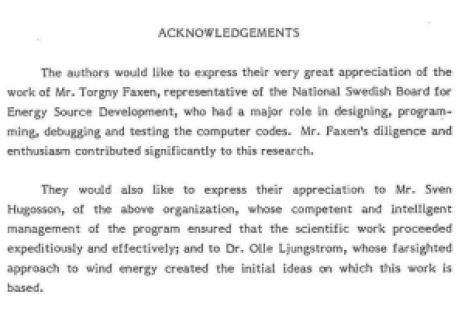
Direct links to the three references are provided below:
- (Lissaman, 1976): personal copy of Torgny Faxén, with its annotations while working on the project.
- (Lissaman, 1977): copy obtained from DTU Wind Energy library, also with annotations.
- (Faxén, 1978): also available on Torgny Faxén’s ResearchGate profile.
Highlights
More detailed posts will follow on the general context of wind energy engineering in the 1970’s (for instance on the cycle of conferences initiated in 1973 by Joseph M. Savino, after the end of the “pionneers” era: Juul, Hütter and Golding). For now, I will focus on providing what I consider to be the main value of the three above-mentioned references, and attempt to put them in perspective with the work which directly followed (in the 1980’s), as well as the work which has been carried out recently.
The work by Lissaman (Lissaman, 1976), is the first of its kind, I believe. It is the first known attempt (to me) to model wind turbine wake in detail using aerodynamics and boundary layer meteorology. Prior to this, Templin published in 1974 about the idea of modelling a wind farm using roughness elements (see “An estimate of the interaction of windmills in widespread arrays“); this led to development of, for instance, the Frandsen model, but the Lissaman detailed formulation of the wake, and the link between wake growth and atmospheric turbulence was truly novel. See below the list of references in (Lissaman, 1976): the main ones are (Abramovitch, 1963) for the theory and observations on jets, and (Lissaman, 1973) which deals with atmospheric pollution and plume dispersion.

The model was elaborated before the first wind turbine wake measurements were carried out. (Higuchi,1977) is quoted on page 5-4, only to say his on-going work may be useful to validate the model. Retrospectively, when looking at the match between the model and the measurements, this approach strikes by its efficiency.
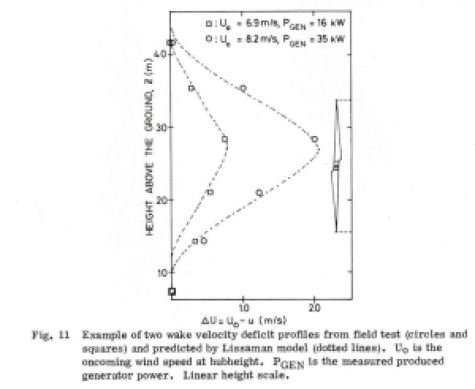
The work by Lissaman focuses from the very beginning on the role of atmospheric turbulence in the wake expansion. In the first part of the report, much of the analytical expressions of the wind speed deficit in the wake are derived from experiments from (Abramovitch, 1963). However in those, the wake develops in a non-turbulent outer flow, whereas as Lissaman rightly points out, plumes (that are wake-like, just with decaying momentum, see page 2-6 and all Section 4) are known to expand more in unstable conditions (large turbulence), than in stable conditions (small turbulence). By means of numerical analysis, Lissaman compares the importance of the contribution of the momentum- and the ambient-generated turbulence in the near and far wake, from which he derives that far from the rotor plane the wake expansion is primarily driven by the ambient turbulence. This result has since then been observed and reported in numerous papers. See the quotes below from (Lissaman, 1976):

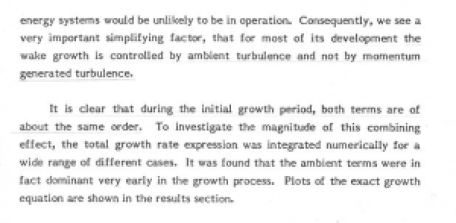
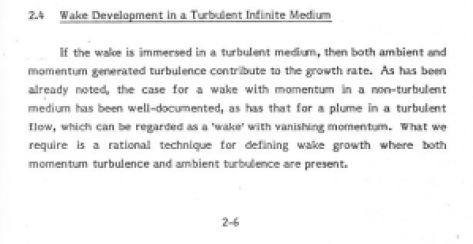
Importantly, Lissaman also derives that the wake expansion is almost linear :

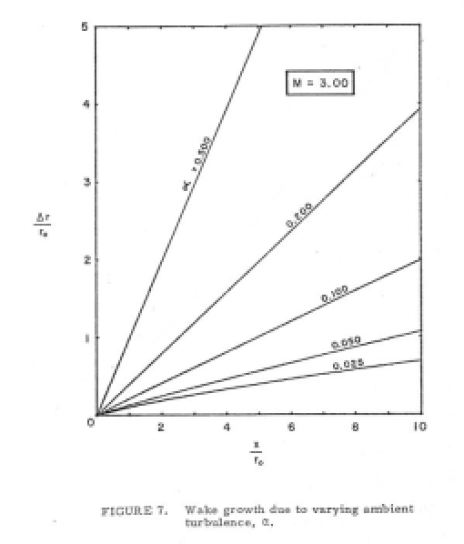
Also appears in (Lissaman and Bate 1977) the classical link between the axial induction factor, the power coefficient, thrust coefficient for an ideal rotor. The Lissaman wind speed deficit model uses the wind speed deficit at the rotor plane combined with an atmospheric turbulence-dependent wake growth, as input to analytical expressions of wind speed deficits within the wake derived from observations in jets. Wake reflection onto the ground is also present in those reports.

Finally (Lissaman and Bate, 1977) proposes a number of wake simulations for several wind farm array configurations, see an example below:
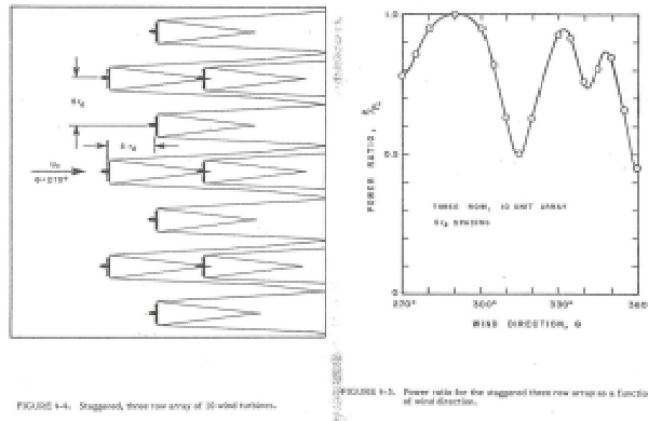
For the purpose of this blog post, I have coded a light version of the N.O. Jensen model (it does not include wake ground reflection), see how it compares below with the calculations from Lissaman. The Lissaman model uses a linear summation of the wind speed deficits, while it is common today to use a quadratic summation. This makes a difference in the heavily waked wind directions.

Wrapping up
Although (Lissaman, 1979) includes all the important aspects of the modelling of wind turbine wake, its brevity was detrimental to the understanding of some of the details of the analysis. Those include primarily the linear- and ambient turbulence dependent wake growth, the link with the aerodynamic performance of an ideal rotor, combined with radial wind speed deficits profiles derived from measurements in jets.
The clarity of the reports makes it easy to understand the physics of the wake as described by Lissaman, and the consequent implementation and validation proved the usefulness of the model and that its basic principles work well.
As mentioned earlier, future posts will investigate in greater details some of Lissaman’s works in wind energy, but also more generally the context of wind energy research in the early 1970’s.
Comments and suggestions are very welcome !
Rémi
